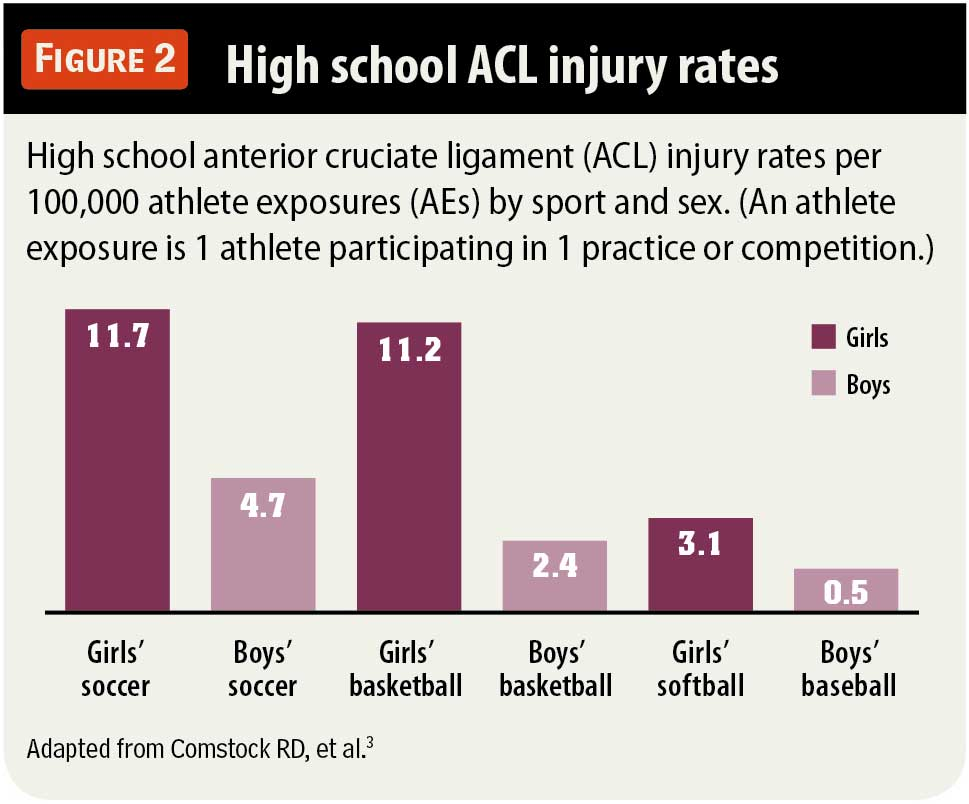ACL injury rates among women athletes have become a pressing concern in the world of sports, drawing attention from researchers and enthusiasts alike. Studies indicate that female athletes are 1.7 times more likely to suffer ACL tears than their male counterparts, shedding light on a complex interplay between biology and athletic performance. While many attribute this higher incidence to biological factors such as hormonal fluctuations and anatomical differences, recent research challenges this narrative by highlighting the impact of social factors like team size and training conditions. Sports science bias often oversimplifies these statistics, neglecting essential elements like the athlete-exposure metrics that fail to account for the resources allocated to male and female athletes. To effectively address ACL injuries, developing focused ACL injury prevention strategies that consider both biological and social factors is crucial.
The alarming prevalence of knee injuries, specifically anterior cruciate ligament (ACL) tears, among female athletes raises questions about the underlying causes and preventive measures. Recent examinations into gender disparities in sports injuries reveal that women face unique challenges that contribute to their increased vulnerability, requiring a shift in how we assess injury risks within this demographic. Factors such as unequal access to training facilities and resources, alongside biological differences, create a multifaceted landscape of injury susceptibility that calls for comprehensive intervention strategies. Understanding the broader context of women athletes’ injury risk is essential in crafting effective prevention programs aimed at mitigating these alarming rates. By re-evaluating traditional metrics used in sports science, we can better protect and empower female athletes in their pursuit of excellence.
Understanding ACL Injury Rates in Women Athletes
The ACL injury rate in women athletes has become a critical topic within sports science, with recent studies revealing the complexities underlying these statistics. Research highlights that women are significantly more prone to ACL injuries than their male counterparts, with rates being approximately 1.7 times higher. However, this higher incidence can often be attributed to factors beyond mere biological differences, such as social and environmental influences. For instance, women generally participate in smaller teams with less rigorous training compared to men, resulting in a greater risk of injury due to less overall physical conditioning.
Notably, community and resource allocation disparities further exacerbate this issue. Women often have fewer opportunities for training and less access to adequate facilities, which can contribute to the development of fundamental strength and fitness levels essential for injury prevention. As such, it is crucial to adopt a holistic view of ACL injuries in women athletes that considers both biological aspects and the socio-economic context in which these athletes perform.
Examining ACL Tear Causes Beyond Biological Differences
Traditionally, the focus on ACL tear causes for women athletes has revolved around anatomical and hormonal differences, such as ligament composition and pelvic alignment. This perspective, however, is increasingly viewed as overly simplistic by experts in sports science. Recent findings suggest that the evaluation of ACL injury risk should include a broader range of factors, including sports participation rates, training environments, and coaching quality. Essentially, while biological sex-related elements may play a role, they do not provide a complete explanation for the higher injury rates observed in women.
For example, the research from Harvard’s GenderSci Lab emphasizes evaluating injury statistics through a more nuanced lens. By prioritizing athlete-exposure metrics that consider the frequency and duration of both games and practice sessions, researchers can better understand the unique challenges faced by women athletes. Such an approach not only helps in elucidating the real causes behind ACL injuries but also facilitates the development of targeted prevention strategies that address the root of the problem.
The Impact of Sports Science Bias on Women Athletes
The discourse around ACL injuries has often been influenced by ingrained biases in sports science. A common narrative places an undue emphasis on biological differences while overlooking systemic issues like training conditions and resource disparities. This bias is evident in existing injury data that fails to account for the lower athlete-exposure metrics for women, which masks the truth behind their increased injury rates. The studies advocated by Richardson and her colleagues challenge these entrenched biases by illustrating how resource allocation plays a crucial role in injury prevalence.
Furthermore, the implications of sports science bias are profound, as they create a skewed understanding of women’s athletic health and undermine efforts to address the disparities. Awareness of such bias must serve as a catalyst for change, prompting researchers, coaches, and policymakers to advocate for enhanced investment in female sports programs. This includes better training facilities, comprehensive coaching education, and more equitable support systems to ensure women athletes have the same opportunities as men to succeed and minimize injury risk.
Key Gender Differences in Sports Injuries
Understanding gender differences in sports injuries, particularly those related to ACL tears, is essential to formulating effective injury prevention strategies. Historically, gender has been a significant variable in athletic health, influencing everything from injury susceptibility to rehabilitation outcomes. Research that thoroughly investigates these gender differences reveals that the phenomena of injuries cannot solely be accounted for by biology; social factors must also be taken into account.
For instance, women’s sports often experience underfunding and fewer access to medical and training resources. This lack of structural support can lead to suboptimal training practices that exacerbate injury incidence. A nuanced evaluation of the interplay between physical attributes and social determinants can provide critical insights into tailoring ACL injury prevention strategies that address the specific needs of women athletes.
Advancing ACL Injury Prevention Strategies for Women
The advancement of ACL injury prevention strategies for women athletes is vital, given the alarming statistics regarding their injury rates. These strategies must be multifaceted and geared towards addressing both physiological and societal factors influencing injury risk. Implementing programs that focus on strength and conditioning tailored to women’s specific biomechanical needs is crucial. Research continues to highlight the importance of comprehensive training that not only improves athletic performance but also fortifies the ligaments and muscles that support the knee.
In addition to biomechanical training, it is equally crucial to advocate for systemic changes within women’s sports programs. From enhanced funding for training resources to equitable access to medical personnel, a holistic approach can substantially reduce the rates of ACL injuries among female athletes. By prioritizing both preventive measures and resource allocation, sports organizations can create safer environments that empower women athletes to reach their full potential without the looming threat of injury.
Reassessing Athlete Exposures in Injury Statistics
The concept of athlete-exposures has been critically reassessed in the context of ACL injuries among women athletes. Many existing studies underestimate the true injury risk by failing to calculate exposures at the individual athlete level or by generalizing data from team metrics. This means that the statistics reported do not accurately reflect the actual risk faced by female athletes, leading to potentially unfounded assumptions about their injury rates being solely biologically driven.
To improve the accuracy of injury risk assessments, researchers advocate for separating practice time from competitive play and employing individual-level calculations. Utilizing refined metrics can shed light on the higher risks faced by women during critical moments in competition, ultimately paving the way for tailored intervention strategies that better protect female athletes from injury.
The Role of Coaching and Training in Injury Risks
Coaching and training play a pivotal role in determining the injury risks faced by women athletes, particularly concerning ACL injuries. Effective coaching that emphasizes biomechanics, conditioning, and injury prevention techniques can significantly mitigate risks. However, inconsistencies in training practices across gender-based programs often lead to disparities in injury rates, as many women’s programs lack the same level of funding and resources as their male counterparts.
Integrating injury prevention into the training regimens of women athletes requires a commitment from coaches to prioritize their athletes’ health. This includes focusing on strength training specific to knee stability and agility drills that mimic game scenarios where injuries are prevalent. Empowering coaching staff with the knowledge and tools to implement these strategies can enhance performance while reducing the likelihood of debilitating injuries.
Improving Research on Gender and Sports Injuries
The need for improved research on gender and sports injuries has never been more critical, especially in light of increasingly recognized disparities in ACL injury rates. Future studies must take into account the complexities of gender as a variable, examining how biological, social, and economic factors interplay in determining injury risks. Comprehensive research methodologies that bridge the gap between social science and sports medicine can illuminate the real drivers of injury rates and inform more equitable health practices.
Moreover, multidisciplinary approaches that involve sports physiologists, sociologists, and gender studies experts can enrich our understanding of women athletes’ health. Research that considers a wider range of variables—such as coaching quality, training environments, and individual athlete challenges—can lead to more effective prevention strategies and ultimately improve overall health outcomes in female athletics.
Creating a Fair Sports Environment for Female Athletes
Creating a fair sports environment for female athletes is integral in addressing the ongoing disparities in ACL injury rates. Equity in access to facilities, coaching resources, and funding must be prioritized to ensure that women can compete on equal footing with men. As the research indicates, when female athletes are supported not just in terms of physical training but also socially and institutionally, the outcomes improve not only in performance but also in injury prevention.
Institutions and governing bodies in sports should actively work to dismantle the barriers that have historically marginalized women’s sports. Policies aimed at fostering diversity and inclusion within athletic programs can lead to significant improvements in athlete exposure and participation rates, thereby contributing to lower ACL injury rates. Commitment from all stakeholders involved in sports—from institutions to individual coaches—can drive change necessary for creating a safer, more equitable playing field.
Frequently Asked Questions
What factors contribute to higher ACL injury rates in women athletes?
Higher ACL injury rates in women athletes can be attributed to a combination of social and biological factors. Research indicates that women may face an increased risk due to underfunded sports programs, smaller team sizes, and differences in training practices. Additionally, ACL injury prevention strategies have often overlooked these disparities, leading to misguided conclusions based solely on biological differences.
What role does sports science bias play in evaluating ACL injury rates among women athletes?
Sports science bias can significantly skew the evaluation of ACL injury rates in women athletes. Traditional athlete-exposure calculations often neglect vital social factors like funding disparities and team sizes, focusing instead on biological explanations. This bias can obscure the underlying causes of higher ACL injury rates and impede effective ACL injury prevention strategies.
How can ACL injury prevention strategies be improved for women athletes?
To improve ACL injury prevention strategies for women athletes, it is essential to address both social factors and training methodologies. Recommendations include accurate measurements of athlete-exposures on an individual level, increased investment in women’s sports, better access to coaching and support staff, and tailored conditioning programs that consider gender differences in biomechanics and injury risks.
Are gender differences influencing the ACL injury rates in women athletes?
Yes, gender differences significantly influence ACL injury rates in women athletes. While some biological factors contribute, recent studies emphasize that social factors, such as team size and training resources, play a critical role. Understanding these gender-specific dynamics is vital for creating effective ACL injury prevention measures that cater specifically to female athletes.
What is the impact of team size on ACL injury rates in women athletes?
Team size directly impacts ACL injury rates in women athletes. Smaller teams may lead to increased exposure time during competitions, subsequently raising the likelihood of injuries. As women often play on smaller teams with less overall practice, their individual injury risk can increase compared to their male counterparts, highlighting a need for better training and resource allocation.
How does understanding ACL tear causes help in reducing injury rates for women athletes?
Understanding ACL tear causes, particularly in the context of women athletes, can lead to targeted injury reduction strategies. By recognizing that social disparities, alongside biological factors, contribute to higher injury rates, sports programs can develop more comprehensive training regimens that focus on enhancing strength, conditioning, and injury prevention tailored specifically for female athletes.
What are the implications of inadequate facilities on ACL injury rates among women athletes?
Inadequate facilities can significantly affect ACL injury rates among women athletes by limiting access to proper training environments and necessary medical resources. Poor quality facilities may hinder optimal conditioning and reduce the overall preparedness of athletes, which is crucial for minimizing the risk of injuries like ACL tears.
Why is athlete-exposure an important metric in assessing ACL injury rates?
Athlete-exposure is a crucial metric for assessing ACL injury rates because it considers the amount of time athletes are actively participating, whether in practice or competition. However, traditional methods often miscalculate this exposure, particularly for women athletes, who may have less practice time and different competitive structures. Accurately measuring athlete-exposure is key to understanding and addressing the higher ACL injury risks faced by female athletes.
| Key Points |
|---|
| Higher ACL injury rates in women athletes often attributed to biological differences and hormonal factors, according to traditional narratives. |
| Recent research argues that these explanations overlook crucial social factors that contribute to injury rates. |
| Women athletes often compete in smaller teams and have higher exposure during competition, increasing their risk of ACL injuries. |
| A study revealed that the ACL injury rate is 1.7 times higher for female athletes, underscoring a need for improved metrics. |
| Simplistic calculations of athlete-exposures failed to account for factors such as actual game participation and training conditions. |
| Improving metrics to separate practice from game time can lead to better understanding of ACL injury risks. |
| The research promotes a thorough investigation into gender-related variables to improve safety and health in sports. |
Summary
ACL injury rates for women athletes have been found to be disproportionately higher due to both biological and social factors. Recent studies indicate that societal influences, such as team size and training opportunities, play a significant role in these injury statistics. By focusing on comprehensive metrics that account for both competition and practice time, researchers aim to offer a clearer understanding of how to reduce ACL injuries in female athletes. This multi-faceted approach highlights the need for equity in sports science research and advocacy for improved training conditions.



